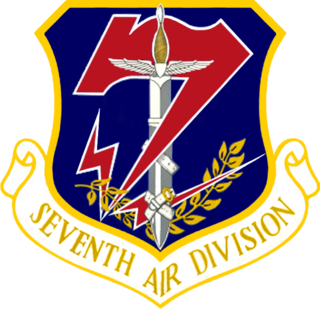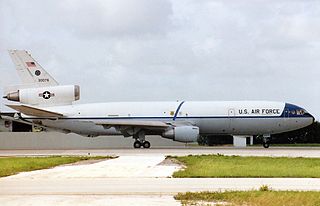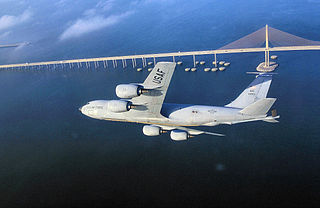
The Eighth Air Force (Air Forces Strategic) is a numbered air force (NAF) of the United States Air Force's Air Force Global Strike Command (AFGSC). It is headquartered at Barksdale Air Force Base, Louisiana. The command serves as Air Forces Strategic – Global Strike, one of the air components of United States Strategic Command (USSTRATCOM). The Eighth Air Force includes the heart of America's heavy bomber force: the Northrop Grumman B-2 Spirit stealth bomber, the Rockwell B-1 Lancer supersonic bomber, and the Boeing B-52 Stratofortress heavy bomber aircraft.

The 7th Air Division served the United States Air Force with distinction from early 1944 through early 1992, earning an outstanding unit decoration and a service streamer along the way.

The 1st Strategic Aerospace Division is an inactive United States Air Force organization. Its last assignment was with Strategic Air Command, assigned to Fifteenth Air Force, being stationed at Vandenberg Air Force Base, California. It was inactivated on 1 September 1991.

The 4th Air Division is an inactive United States Air Force unit. Its last assignment was with Fifteenth Air Force, stationed at Francis E. Warren Air Force Base, Wyoming. It was inactivated on 23 August 1988.

The 19th Air Division is an inactive United States Air Force formation. Its last assignment was with Eighth Air Force at Carswell Air Force Base, Texas, where it was inactivated on 30 September 1988.

The 47th Air Division is an inactive United States Air Force unit. Its last assignment was with Strategic Air Command at Fairchild Air Force Base, Washington. It was inactivated on 27 February 1987.

The 73d Air Division is an inactive United States Air Force unit. Its last assignment was with Air Defense Command at Tyndall Air Force Base, Florida, where it was inactivated on 1 April 1966.

The 392d Air Expeditionary Group is a provisional United States Air Force unit. It is assigned to Air Combat Command to activate or inactivate as needed. The group was last active as the 392d Strategic Missile Wing at Vandenberg Air Force Base, California, where it briefly operated three early models of intercontinental ballistic missile during 1961. In 1984, the wing was consolidated with the 392d Bombardment Group

The 512th Rescue Squadron is part of the 58th Special Operations Wing based at Kirtland Air Force Base, New Mexico. It formerly operated the Bell UH-1N Twin Huey and currently operates the Sikorsky HH-60G Pave Hawk and the new HH-60W Jolly Green II helicopters training aircrew conducting search and rescue missions.

The 91st Air Refueling Squadron is part of the 6th Air Mobility Wing at MacDill Air Force Base, Florida. It operates the Boeing KC-135R Stratotanker aircraft conducting air refueling missions.

The 531st Bombardment Squadron was a unit of the US Air Force, first activated during World War II. After training as a heavy bomber unit in the United States, it moved to the Southwest Pacific Theater, entering combat in May 1943, flying combat missions from Australia while attached to the Royal Australian Air Force, earning two Distinguished Unit Citations and a Philippine Presidential Unit Citation. In 1945 it moved forward to the Philippines, then to Okinawa. Following V-J Day, the squadron returned to the Philippines and was inactivated there in February 1946.

The 303rd Air Expeditionary Group is a provisional United States Air Force unit. In 2011, it was assigned to United States Air Forces Europe to activate or inactivate as needed.

The 93d Operations Group is an inactive United States Air Force unit. Its last assignment was with the 93d Air Control Wing, stationed at Robins Air Force Base, Georgia. The unit was inactivated on 1 October 2002.

The 482d Operations Group is a United States Air Force Reserve unit assigned to the 482d Fighter Wing. It is stationed at Homestead Air Reserve Base, Florida.

The 90th Operations Group is the operational component of the 90th Missile Wing of the United States Air Force. It is stationed at Francis E. Warren Air Force Base, Wyoming, and is assigned to Twentieth Air Force of Air Force Global Strike Command. The group is responsible for maintaining and operating on alert the wing's assigned LGM-30G Minuteman III intercontinental ballistic missiles.

The 53rd Electronic Warfare Group was a component of the 53rd Wing of the Air Force Warfare Center, Air Combat Command, headquartered at Eglin Air Force Base, Florida.

The 513th Electronic Warfare Squadron is a United States Air Force unit assigned to the 350th Spectrum Warfare Group at Eglin Air Force Base, Florida.

The 366th Bombardment Squadron is an inactive United States Air Force unit. It was first activated in March 1942. After training with Boeing B-17 Flying Fortress bombers in the United States, the squadron deployed to the European Theater of Operations, where it participated in the strategic bombing campaign against Germany. The squadron was twice awarded the Distinguished Unit Citation for its combat actions. Following V-E Day, it moved to the continent of Europe and engaged in photographic mapping until inactivating in December 1946.

The 365th Bombardment Squadron is an inactive United States Air Force unit. It was first activated in March 1942. After training with Boeing B-17 Flying Fortress bombers in the United States, the squadron deployed to the European Theater of Operations, where it participated in the strategic bombing campaign against Germany. The squadron was twice awarded the Distinguished Unit Citation for its combat actions. Following V-E Day, it moved to the continent of Europe and engaged in photographic mapping until inactivating in December 1946.

The 364th Bombardment Squadron is an inactive United States Air Force unit. Its last assignment was with the 305th Bombardment Wing at Bunker Hill Air Force Base, Indiana, where it was inactivated on 1 January 1970. The squadron was first activated in March 1942. After training in the United States, it moved to England in the fall of 1942, where it participated in the strategic bombing campaign against Germany, earning a Distinguished Unit Citation for its actions. Following V-E Day, the squadron moved to Germany, where it formed part of the occupation forces until inactivating in December 1946.




















